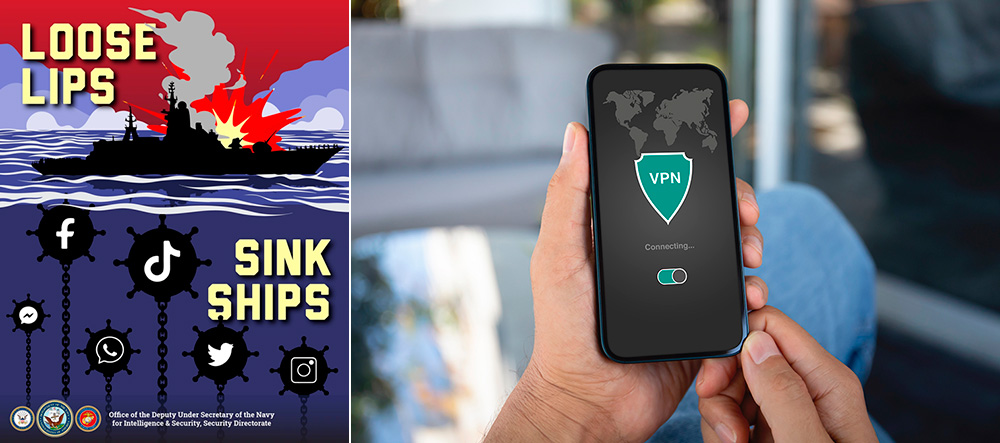
Your information is tremendously valuable to those who would exploit it. Information-target indicators are any visible or accessible signs that can reveal sensitive, personal data to predators or criminals. These indicators—both physical and digital—when left unchecked provide an easy avenue for exploitation that could result in identity theft, home invasion, human trafficking and the like.
Information security is a “best practice” aimed at safeguarding such data, whether it’s posted on social-media platforms or exposed through observable traits in daily life. How can you protect yourself, your family and your identity to minimize these indicators? What are the simple steps you can take to drastically reduce your chances of being targeted?
Your information is a high-value target to a predator. That may sound dramatic, but it is an unavoidable truth today. You don’t have to be a CEO, a celebrity or a high-level government employee to be watched, tracked or exploited. If you use e-mail, carry a smartphone, have an address, a job, a family or even just a digital footprint—you are a target. Every time you reveal a detail about your life, whether online or in public, you contribute to what intelligence professionals refer to as an information-target indicator.
Information-target indicators are signals, sometimes subtle and sometimes glaringly obvious, that reveal something useful to those with malicious intent. These indicators can be physical—like a bumper sticker showing where your child goes to school—or digital, such as a birthday posted on social media. They can be vocal, like your phone number said aloud in a store, or visual, like a work badge hanging from your rearview mirror. Taken alone, each may seem harmless. Combined, they can build a map of your life detailed enough for someone to exploit.
To a predator, criminal or cyber-threat actor, these indicators are gold. They don’t need to hack into a secure database or intercept encrypted messages. They simply need to observe, listen and connect dots. With enough fragments, an attacker can impersonate you, guess your passwords, stalk your movements, plan a break-in, steal your identity or even target your children. The more freely you give this information away, the easier their job becomes.
Information Security (InfoSec) is the discipline that addresses this danger. Originally developed for the defense-intelligence communities, InfoSec was designed to safeguard the kind of data that—if compromised—could endanger missions, expose operatives or shift the balance of global power. But, the relevance of InfoSec has long since spilled beyond classified documents and government servers. In today’s world, it applies to everyone.
The same tools and principles that protect national security are increasingly critical to protecting individual security. Civilians may not be handling state secrets, but they do handle banking credentials, personal identifiers, family schedules, cloud storage, GPS-linked devices and digital habits—all of which form a profile that can be accessed, harvested and used against them if left unsecured.
What once required a spy network now only requires a laptop and an unknowing person who isn’t paying attention. In that sense, information security is no longer a luxury; it’s a necessity. And, it begins not with technology, but with awareness.

Throughout the defense-intelligence community, InfoSec has always been the invisible shield that holds operations together. It’s not just about technology or encryption—it’s about behavior. Secrecy, compartmentalization, misdirection and strict need-to-know boundaries are baked into the very culture of military intelligence. Access is not given freely. It’s earned, tiered, tracked and revoked when no longer needed. This mindset isn’t paranoia. It’s discipline.
That discipline was born long before computers. Ancient military leaders knew secrecy could mean the difference between victory and defeat. Ciphers, encoded messages and secure couriers were used to transmit orders during war. Julius Caesar’s famous substitution cipher, now taught in elementary cryptography, was one of the earliest examples of structured information control.
During World War II, secure communications took on unprecedented importance. The German military’s Enigma machine allowed encrypted messaging across the front lines. The Allies’ effort to break that encryption at Bletchley Park, led in part by Alan Turing, helped shorten the war and save millions of lives. It was a battle not of bullets—but of information—and it marked the true beginning of modern InfoSec.
After the war, the Cold War ushered in an era of surveillance, counter-surveillance and data compartmentalization. Intelligence agencies classified data at multiple levels, enforced need-to-know rules, and used strict protocols for transmission. Even the mere existence of some projects was considered Top Secret.
With the rise of digital computing in the 1980s and 1990s, the entire field of information security evolved rapidly. And yet, even as the technical tools advanced, the fundamental principle remained the same—protect what matters, control who sees it and assume that someone is always watching.
What changed in the 2000s was the scale. The internet transformed the world into a hyper-connected ecosystem. Data began flowing faster and more freely than ever before—across borders, platforms, devices and users. This created new vulnerabilities, and new opportunities for exploitation. It also created an illusion of safety. People trusted the tools they used without understanding them.
Suddenly, civilians were generating more sensitive data than governments imagined possible. Photos, messages, passwords, health records, financial accounts, real-time locations and private communications were all being stored, shared and synced—often without encryption, oversight or consent. The public became its own soft target.
Predators and adversaries adapted quickly. Identity thieves no longer needed to dumpster dive for account numbers—they could send phishing e-mails. Stalkers didn’t need to follow their targets physically; they just needed access to location data on a child’s Snapchat story. Criminals didn’t need to guess passwords—they simply collected enough data to reset them through benign-looking forgotten-password links.
The tactics used by adversaries in military contexts—phishing, deception, impersonation, data aggregation—were retooled for civilian use. The result is the rise of ransomware attacks, mass data breaches and coordinated social-engineering campaigns that target regular people.
The difference between a secure person and a vulnerable one is rarely about how much information they have, it’s about how much they expose. The core insight of InfoSec is that visibility equals vulnerability. The more someone knows about you, the more power they have to act without your permission.
What once required a spy network now only requires a laptop and a target who isn’t paying attention. In that sense, information security is no longer a luxury; it’s a necessity.
Most of us expose more than we realize. Stickers on our vehicles reveal where our children go to school, what sports they play, in what military units we served or what causes we support. Badges or uniforms worn in public can identify our employer or role. Social-media posts show where we are, who we’re with and when we’ll be away from home.
Even our conversations can betray us. Loudly repeating a phone number in a public space, reading off a credit card to someone over the phone or casually mentioning the hotel you’re staying at are all vocal indicators that can be overheard, logged and acted upon by someone with bad intentions.
What makes this so dangerous is how easily overlooked it all is. These aren’t high-stakes espionage failures. Unfortunately, they’re everyday oversights.
Digital behavior is no better. Posting your child or grandchild’s name, school and birthday online may feel like a celebration, but it can also hand a predator the exact information they need to impersonate you, socially engineer a password reset or gain your child’s trust online. Taking a picture of your plane ticket may seem like a humblebrag, but it reveals your full legal name, travel plans and booking number.
Children in particular are high-risk targets because they are trusting, digitally active and largely untrained in information discipline. They overshare online. They download apps without understanding the permissions they grant. They live in a world of constant visibility, where privacy is seen as optional or even antisocial. Yet, it is precisely this openness that predators exploit.
Parents must teach children how to think critically about what they post, with whom they engage and what signs they’re broadcasting. It means adjusting privacy settings, using parental controls and modeling smart behavior. Furthermore, it means having conversations that go beyond “stranger danger,” conversations about identity, data control and ultimately about consequences.
For adults, the shift must also be cultural. Too many people believe that if they’re not doing anything wrong, they have nothing to hide. However, privacy is not about guilt, dignity, safety or control. You don’t lock your front door because you’re doing something illegal inside. You lock it because it’s your space, and no one should enter without your permission.
The same logic applies to your data. Just because your information is shareable doesn’t mean it should be. Just because it’s convenient to post doesn’t mean it’s safe to post. InfoSec isn’t about becoming paranoid. It’s about becoming strategic.
A basic rule of thumb is this: If the information could be used to impersonate you, track you, target you or manipulate you—it should be protected. That doesn’t mean disconnecting from the world, avoiding the internet or living in fear. It means moving through daily life with a sense of intentionality—aware of what you’re signaling and to whom.
Intentionality begins with awareness. Most people don’t realize just how much personal data they’re giving away for free. Every social-media profile, online review, tagged photo, digital receipt or wearable device becomes another thread in the tapestry of your digital identity. A threat actor doesn’t need all your data—they just need the right pieces.
There are simple ways to begin regaining control. One of the most effective is to perform a personal digital-hygiene review. Start with your social-media accounts. Look through your posts, your likes, your friends list, your photo meta data and your bio. Are you disclosing your birthday? Your pets’ names? Your location history? Have you ever posted a child’s school uniform, a boarding pass or a street sign in the background of a photo? These aren’t just memories, they are signals. They can be the digital equivalent of leaving your front door open.
Take time to regularly check your privacy settings—don’t assume platforms will preserve them by default. Make it a quarterly habit to verify who can see your content, who can contact you, and how much of your information is visible in search engines or to third-party apps. Limit visibility to trusted individuals whenever possible.
In the physical world, your vehicle, home and even your trash can reveal volumes. Assess your personal space. It can attract not only identity thieves, but burglars who target homes based on perceived value or vacancy.

At home, evaluate what is visible through windows, on porches or from your mailbox. Even seemingly minor oversights can provide clues to someone casing your residence for potential access or vulnerability.
Then turn your attention to your devices. Smartphones, tablets and computers are often the single richest source of personal data. Are your apps silently collecting and transmitting location data? Disable Bluetooth and location services when not in use. Encrypt your devices and enable remote-wipe features in case of loss or theft.
Public Wi-Fi is another common point of compromise. Avoid connecting to open, unsecured networks, especially at airports, cafés, and hotels. If you must use one, connect through a trusted virtual private network (VPN).
Passwords deserve special attention. Use strong, complex and unique passwords for every critical account. Password reuse is one of the top ways hackers gain access—if one site is breached, all other accounts using the same credentials are vulnerable. Add two-factor authentication to your accounts whenever it is available, especially for e-mail, banking and cloud storage.
The essence of InfoSec is not to eliminate exposure entirely; that’s impossible in a connected world. Instead, it is to control or mitigate exposure, understand that every digital action carries a signature and recognize that every physical habit has a pattern. To understand that, recognize that invisibility is not the overall goal—resilience is. You want to be unpredictable, unexploitable and unprofitable as a target. The goal is deterrence through difficulty.
The good news is that prevention is not only possible, but also entirely within your reach. InfoSec is not about expensive tools or elite clearance levels. It’s about cultivating a mindset, awareness, discipline and boundaries. It’s a personal practice that, when maintained, becomes second nature. Like locking your door without thinking twice, InfoSec becomes a reflex.
The digital world is not inherently dangerous, but it is indifferent to your safety. That responsibility rests with you. Every decision—to post or not, to click or pause, to speak aloud or show silently—adds up to a posture. That posture is either proactive or reactive, fortified or exposed. You don’t have to disappear. You just must stop offering yourself up.
Your data is a reflection of your identity. And in the digital age, identity is power. It opens accounts, grants access and determines trust. Treat it like the currency is because in many cases, it’s more valuable than cash. Though inconvenient, a compromised account can be restored. A compromised identity can haunt you for years.
When you stop broadcasting and start thinking, the power begins to shift. You stop being a passive node in someone else’s network. You start becoming a sovereign agent; aware, selective and strategic. You transform from a soft target to a hardened one, and you teach those around you—your family, your children, your co-workers—that information security is not just a setting. It’s a vital skill.



































